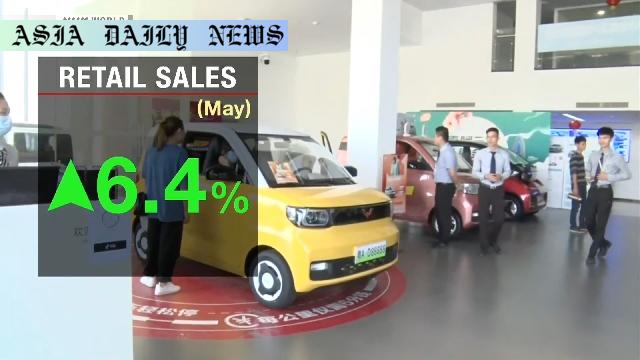China Industrial Output – Industrial production in May rose 5.8% year on year but showed a downward trend from April’s 6.1%.
China’s industrial output grew by 5.8% in May, falling from April’s 6.1% growth.
Real estate investment dropped significantly, showing a prolonged slump in the property sector.
Retail sales climbed 6.4% year on year, spurred by government subsidies for major goods.
Concerns about US-China trade relations persist despite eased tariffs and renewed negotiations.

China’s Industrial Output: Analyzing the Month-Over-Month Decline
Recent statistics from the National Bureau of Statistics in China have painted a concerning picture of the country’s industrial health amidst evolving international trade dynamics. In May, industrial output increased by 5.8% compared to the same period the previous year. While this growth is notable, it fell short of the 6.1% benchmark registered in April, indicating a slowdown. This can largely be attributed to the effect of trade tariffs initiated by the United States, which disrupted export markets and created new operational hurdles for businesses reliant on global markets. Notably, the cumulative effects of these measures underscore vulnerabilities within the industrial sector, highlighting how external pressures can temper domestic economic gains during periods of elevated global scrutiny.
The Real Estate Sector: An Unprecedented Slump in Investments
China’s property market has continued its downward trajectory, with investments in real estate experiencing a 10.7% decline over the first five months of 2023. Such a significant drop has sent ripples through the economy, reflecting deeper macroeconomic challenges. Additionally, home prices saw reductions in 53 out of 70 primary cities, a stark rise from the previous month’s figures. These developments signify not only a protracted slump within the real estate market but also a potential recalibration in China’s broader economic policies aimed at stabilizing an overstretched sector. Mitigating this slump will require strategic government interventions or innovative approaches from the private sector to inject life back into property investments.
Retail Sales: A Glimmer of Growth Amid the Gloom
Amidst the broader economic uncertainties, one bright spot for China’s economy came in the form of retail sales. Recording a growth of 6.4% year on year in May, this sector outperformed April’s figures by a significant margin. The Chinese government’s strategic implementation of subsidies for certain consumer goods, including automobiles and household appliances, provided much-needed stimulation. Such measures also highlight Beijing’s intent to bolster domestic consumption as a counterbalance to external economic pressures. Retail resilience, while promising, poses questions about its sustainability without continued financial interventions.
Trade Relations: Navigating a Fragile Truce
The ongoing trade friction between the United States and China continues to cast a shadow over global economic stability. Despite the mutual rollback of additional tariffs in May, the underlying tensions have not subsided. Negotiations between Beijing and Washington have resumed, fostering cautious optimism. However, the risk of reignited conflicts remains a concern, especially as both nations prepare for future economic showdowns in strategic sectors like technology. Proactive measures will be crucial to ensuring this temporary detente does not unravel, providing a stable foundation for global trade growth.
In conclusion, the interplay between industrial output, property market contractions, retail growth, and trade dynamics highlights the multifaceted challenges China faces in navigating its economic stability. Whether through deliberate policy restructuring or external collaboration, addressing these critical issues will determine China’s trajectory in the face of global economic interconnectedness.



Commentary
Industrial Downturn Reflects External and Domestic Challenges
The latest figures from China’s industrial sector tell a compelling story about the significance of external influences on domestic economies. The steady decline in production growth rates from April to May is a stark reminder of how intertwined the world’s economies have become. Considering that the US tariffs have created ripple effects across various Chinese industries, it’s evident that such trade measures can have long-lasting implications. While the slowing industrial output still shows growth, governments and private enterprises need to reconsider their positioning amidst geopolitical competition.
A Crippling Property Market Requires Attention
China’s real estate crisis offers a poignant assessment of what happens when a sector critical to the national economy slides into a prolonged slump. With urbanization still underway in many parts of the country, the drastic reduction in real estate investments speaks to broader financial hesitations affecting developers and buyers alike. Property markets are frequently seen as reserves of wealth in many economies, but ongoing reductions in home prices and investment activity suggest a diminishing confidence level in the sector. Substantive reforms or innovative stimulus measures could perhaps reset this downward spiral.
Retail Reshapes a Resilient Economy
It’s not all doom and gloom for the Chinese economy. Retail sales remain an inspiring signal of potential resilience. The 6.4% growth recorded in May compared to the prior month reflects Beijing’s ability to mobilize domestic consumption through targeted subsidies and deliberate policy. Going forward, the sustainability of retail as an engine of growth largely hinges on creating a self-reliant consumer culture at its heart. If supply chains adapt alongside efficient government policies, the retail sector could maintain its upward trajectory.
Overall, these interconnected areas highlight China’s prowess and limitations in tackling an era of growing uncertainties. Policy adaptability and proactive measures will remain pivotal for the country’s continued evolution amid shifting global landscapes.